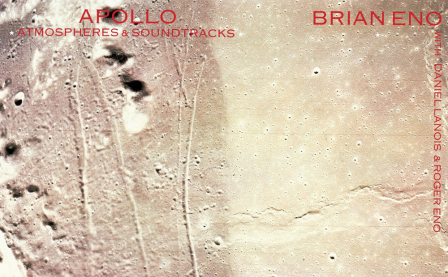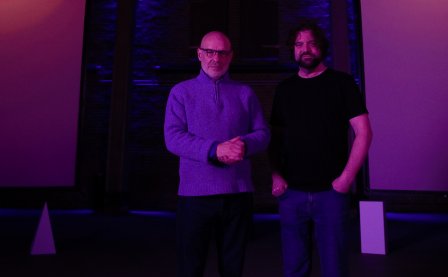Ultimately, taste is irrelevant. It draws us through creation and consumption, suggesting meaning, suggesting a getting there. Sometimes we find its gratification — perhaps blissful reward — and at other times we find dead ends: no action, it falls short. All the aesthetic meaning you have found starts to crumble when it can’t be relayed, when relation falls short, when the hot springs of expression turn up dry.
In 2013, Eno tells Laurie Anderson: “I periodically realize every few years that the only person whose taste I really trust is me. [both laugh] Well, I don’t say that to mean my taste is good or anything like that. It’s just consistent.” No one that Eno consulted had liked the cover art he’d made for what was then his latest. Eno decided to go with his gut on it, which has been a guiding maxim for many of his creative ventures. This principal functions well in many cases but muddies the concepts behind his supposedly more objective processes: taste predicated by a vague conception of some procedural and “scientific” process (Eno (1979): “my resources of information are kind of quasi-scientific”).
Reflection is a generative piece, which Eno defines (in the Eno on Reflection portion of his current site): “[generative pieces] make themselves. My job as a composer is to set in place a group of sounds and phrases, and then some rules which decide what happens to them.” Eno acknowledges the limits of the record format (something that indeterminacy miners like Cage and Wolff have long since bemoaned) and provides a generative iOS app of Reflection, which produces a live endless stream (i.e., river) of the piece for anyone who can forfeit $30.99 for it (Apparently this price may be different in the UK, but the Version 1.0.3 notes on the store are somewhat unclear about this. At their least, they suggest that the app’s creators “always intended REFLECTION to be a premium priced app”). This pricing raises critical concerns regarding accessibility. Ambient works provide “provocative spaces for thinking,” now “music [that will] unfold differently all the time — ‘like sitting by a river’: it’s always the same river, but it’s always changing.” The critiques here feel so blatant (who can afford to sit with the stream?) that I can only imagine one critical argument for the pricing that I might buy into: if the cost of access is undeniably expensive, the consumer will likely more fully engage with the work until they feel value has been regained through personal experience. At best, then, the generative app form of Reflection encourages a practice of deep listening and something like meditative thoughtfulness. At worst, however, it becomes a fairly expensive and trivial sonic wallpaper, decorating a space for a dinner party (and, by the way, it’s never the same). This brings me to the question of intent as it relates to taste and aesthetic.
First, Derrida: “We do not object to the drug user’s pleasure per se, but we cannot abide the fact that his is a pleasure taken in an experience without truth.” Taste, aesthetic, genre, vocabulary, and mode all function through social exchange. Scenes emerge via class and classification (race, gender, sexuality, age, geography). This is how we learn to love our music and thus how the love of some music can seem so alien to others. We learn the music’s tendencies, what to expect and how those expectations will be sustained and gratified, how they are subverted. We relate certain sounds to periods of our lives and the ones who introduced us to them. We pine for what spaces (venues and forums) a love of certain music might grant us access. In this way we get the experience of music that, yes, functions like a drug. Sianne Ngai:
…when someone proclaims that she finds a tree or a poem beautiful, the force of the conviction underlying the judgement tends to route our attention immediately back to the sheer event of her having found it so. This is why it can be so strangely difficult to respond to someone’s passionate declaration that something is beautiful, whether one agrees with the person’s judgment or not. Whether we nod in sympathetic agreement or politely say nothing, we are likely to feel like any response we might have to the response of the judging subject, however not unwelcomed, is somehow beside the point.
And quickly, back to Derrida, “we cannot abide the fact that [the drug user’s pleasure] is a pleasure taken in an experience without truth.” Strong aesthetics (like beauty) seize attention and enrapture, they are their own truth to the subject who perceives them. This is the importance of one aesthetic of Ngai’s interest: the interesting.
Ngai notes, “when someone feels compelled to make public his evaluation of an object as interesting, we seem equally compelled to ask immediately: why?” This compulsion is a mark of the lack of finality in the judgement of the interesting, an aesthetic that centers and produces consideration, evidence, and dialogue. Hence, Eno’s oft-repeated conclusion in his liner notes for his first proper “Ambient” album that “Ambient Music must be able to accommodate many levels of listening attention without enforcing one in particular; it must be as ignorable as it is interesting.” Theorist Francois Jullien might relate this to the aesthetic of blandness; Ngai herself suggests that there is something similar between the interesting and the cool. These aesthetics are all in some way about striking a very precarious balance: blandness, a field that must not be overcome; coolness, a putting forward that is both uncaring and novel.
Ngai points to the balancing act with which the interesting engages: “the interest of a theory is inversely proportional to the probability of its thesis and directly proportional to the provability of its argument.” In art, an aesthetic combination or formal arrangement is all the more interesting if it seems improbable and nonetheless seems to work. This is perhaps what made Eno’s 2016 release The Ship rather interesting: it featured collage-y, vocoder-laden, spacious extended song-pieces with a spoken word narrative in its midst and a Velvet Underground cover to end it (this cover landed fifth on Pitchfork’s “The Year in Disappointment 2016” list, perhaps a testament to its idea — it must’ve been interesting at first to go on to cause disappointment). However, the aesthetic combination found on Reflection no longer carries much of the threat of non-function.
Its strikes, drones, and delay are secure grounds to build an album upon. So are its long form and uneventfulness. So, while the threat that Ambient 1: Music for Airports posed nearly 40 years ago is carefully rehashed with each installment of Eno’s Ambient series, its effectivity has been nullified by decades of innovations toward (and bastardizations of) ambient music as a concept/genre. Consider NON co-founder Chino Amobi’s 2016 release Airport Music for Black Folks, which, with its title, at least suggests a lineage out of Eno’s Music for Airports going forward to break conventions and expectations accordingly. Like Eno’s, Airport Music for Black Folks features repetitive movements with minimal yet immersive material, manipulated unpredictably with each iteration. Different, however, is the intensity of the material, the use of language and voice, and the brevity of movements. Whether or not Airport Music for Black Folks or music by NON affiliates like Dedekind Cut are within the realm of (proper) ambient music (most would say they aren’t) is irrelevant to the fact that they engage with generated musical atmospheres: the creation of space. Whereas Eno’s textures sink into the background, effecting our thoughts as wallpaper might, allowing meditation and quiet contemplation, perhaps the cold reflective aggression of Chino Amobi’s gunshots within their steady, affective atmospheres may cue and trigger thoughts, attitudes, and actions.
This is all not to say that there is no space for ambient music to evolve in the forms it has thus been known (consider the minimal slippages of TMT favorite Huerco S.) — music that is interesting precisely because it is “as interesting as it is easy to ignore” — but that Eno’s continuation of his flag-bearing series is about as ignorable as it has always been with waning levels on the side of interest.
More about: Brian Eno




